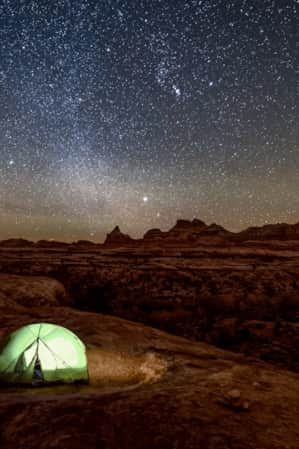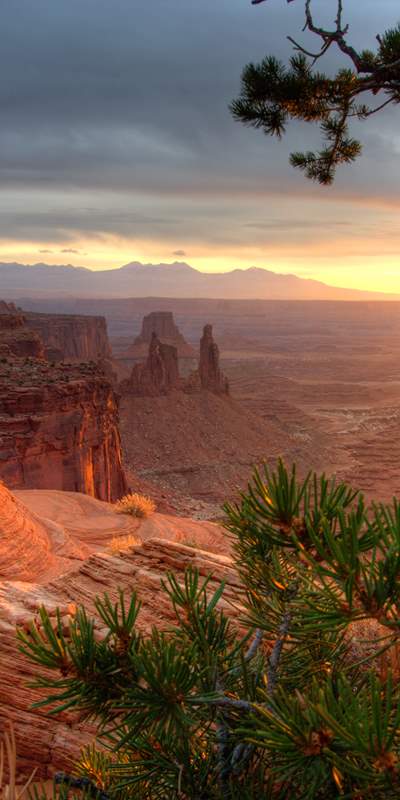Backpacking in Canyonlands National Park
"Know Before You Go" and other serious precautions of safely traveling the backcountry of Southern Utah

Canyonlands National Park offers a spectrum of backpacking opportunities — from short trips at designated backcountry campsites to longer, adventurous trips that require extensive planning and desert canyon navigational knowledge. Overall the most important consideration and trip limiting factor is water availability. There is very little water in the backcountry of the park, requiring backpackers to pack in most, if not all of their water.
The Needles District of the park offers the widest variety of backpacking experiences with numerous designated campsites to choose from across an intricate labyrinth of canyons and expansive grassy parks. For more adventurous and well-planned trips, the NPS allows what is called "at-large" backpacking or at-large camping in areas such as Lavender Canyon and Lower Salt Creek in the Needles District, in most of the Island in the Sky District, and all of the Maze District. In these areas, backpackers can choose their own low-impact sites following the regulations below.
All at-large campsites must be:
- At least 1 mile from a trailhead or road, including backcountry roads.
- 300 feet from any water source, including seeps, potholes, springs, and streams, not including the Green and Colorado Rivers.
- 300 feet from any archaeological site, including alcoves, rock art, surface scatters of lithics or ceramics, and partial or complete structures or ruins.
- Within the zone for which the permit is issued.
- In an area open to at-large camping.
- Left with the least possible evidence of use and environmental impact.
- Located on rock surfaces, dry-sandy wash bottoms, or surfaces without cryptobiotic soil crusts or vegetation.
- Accessed by the least-impacting route, using washes or rock surfaces to reach the campsite.
Contact the Canyonlands National Park Backcountry Permit Office for more information and assistance with trip planning, canyres@nps.gov or (435) 259-4351, and watch a short video to aid in trip planning.
Below is backpacking route in Canyonlands to get you started. For detailed backcountry camping information, visit the official Canyonlands National Park website backpacking page.
The Big Needles Loop (Canyonlands National Park, Needles District): 23.2 miles. A major backpacking trip covering most of the outstanding features of the Needles District of Canyonlands National Park.
Know Before You Go
You might never know what hit you.
The high desert environs of Canyonlands are prone to sudden thunderstorms, especially in spring and summer months. If you get caught by a lightning storm, take special precautions. Remember:
- Lightning can travel far ahead of the storm, so be sure to take cover before the storm hits.
- Don’t try to make it back to your vehicle. Instead, seek shelter, even if it’s only a short way back to the trailhead. Trying to make it is not worth the risk. Lightning storms usually don’t last long, and from a safe vantage point, you might enjoy the sights and sounds.
- Be especially careful not to get caught on an exposed ridge; under large, solitary trees; in the open; or near standing water.
- Seek shelter in a low-lying area, ideally in a dense stand of small, uniformly sized trees.
- Stay away from anything that might attract lightning, such as metal tent poles, trekking poles, or pack frames.
- Get in a crouched position and place both feet firmly on the ground.
- If you have a pack (without a metal frame) or a sleeping pad with you, put your feet on it for extra insulation against shock.
- Don’t huddle together. Instead, sit 50 feet apart, so if somebody gets hit by lightning, others in your party can give first aid.
- If you’re in a tent, stay there, in your sleeping bag with your feet on your sleeping pad.
Read these additional resources to learn how to travel thoughtfully and experience Canyonlands National Park most fully.

Hypothermia and Hyperthermia
These are two things you never want to experience. Trust me; I’ve had both.
In most hiking areas hypothermia, or the silent killer, as it’s called, is the biggest threat to backcountry travelers. In desert environs, however, hyperthermia, especially the most serious form, heat stroke, can be equally dangerous.
And you can get both while hiking Canyon Country.
Hypothermia, a condition in which the body’s internal temperature drops below normal, can — and way too often does—lead to mental and physical collapse and death. It’s caused by exposure to cold and is aggravated by wetness, wind, exhaustion, and dehydration. The moment you begin to lose heat faster than your body produces it, you’re suffering from exposure. Your body starts involuntary exercise, such as shivering, to stay warm and makes involuntary adjustments to preserve normal temperature in vital organs, restricting blood flow in the extremities. Both responses drain your energy reserves. The only way to stop the drain is to reduce the degree of exposure.
With full-blown hypothermia, as energy reserves are exhausted, cold reaches the brain, depriving you of good judgment and reasoning power. You won’t be aware that it’s happening. You lose control of your hands. Your internal temperature slides downward. Without treatment this slide leads to stupor, collapse, and death.
To defend against hypothermia, stay dry. When clothes get wet they lose about 90 percent of their insulating value. Wool loses relatively less heat; cotton, down, and some synthetics lose more. Take good rain gear that covers the head, neck, body, and legs and protects against wind-driven rain. Most hypothermia cases develop in air temperatures between 30 and 50 degrees Fahrenheit, but hypothermia can develop in warmer temperatures.
If your party is exposed to wind, cold, and wet, automatically think hypothermia. Watch yourself and others for these symptoms: uncontrollable fits of shivering; vague, slow, slurred speech; memory lapses; incoherence; immobile or fumbling hands; frequent stumbling or a lurching gait; drowsiness (to sleep is to die); apparent exhaustion; and inability to get up after a rest. When a member of your party has hypothermia, he or she may deny any problem. Believe the symptoms, not the victim. Even mild symptoms demand treatment, as follows:
- Protect the victim from wind and rain.
- Remove all wet clothing and keep the victim dry.
- Get the victim into warm clothes and a dry sleeping bag.
- Place well-wrapped water bottles filled with heated water close to the victim, especially next to the neck, chest, and groin.
- Try to get the victim to ingest warm liquids, but don’t force it.
- Attempt to keep the victim awake.
Hyperthermia can manifest itself in several forms — heat cramps, heat exhaustion, and heat stroke, the most serious and life-threatening form and a definite medical emergency.
Your body normally generates heat, especially during vigorous physical exercise, and dissipates that heat through the skin or by evaporation of sweat. When hiking in intense heat under the sun, especially if you’re dehydrated, the body may not be able to dissipate enough heat and the body temperature rises. Not a good thing.
The advanced form of hyperthermia, heat stroke, is life-threatening. A person with heat stroke usually has a body temperature above 104 degrees Fahrenheit. Other symptoms include confusion, combativeness, bizarre behavior, faintness, staggering, strong and rapid pulse, and possible delirium or coma.
Heat stroke is often preceded by heat exhaustion, which is a warning sign that the body is getting too hot. Symptoms include acute thirst, weakness, lack of coordination, nausea, profuse sweating, and cold, clammy skin.
To treat heat stroke, seek emergency assistance as soon as possible. In the meantime:
- Get the victim out of the sun into a cool place, if possible.
- Encourage drinking water or other fluids, but nothing with alcohol and caffeine.
- Immerse in water, if possible, or sponge off the victim with cool water, again if possible.
- Urge the person to lie down and rest, preferably in a cool place.
To prevent heat exhaustion and heat stroke and other forms of hyperthermia, avoid dehydration by carrying and drinking a lot of water during your hike, especially at the beginning of the hike when you aren’t thirsty and don’t think you need fluids.






